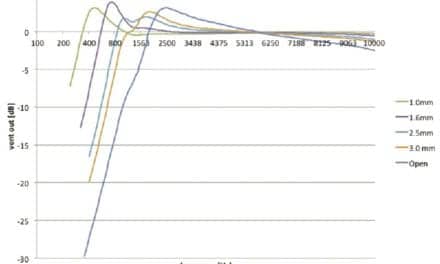
|
| George Lindley, PhD, AuD |
The release of the Amigo product line by Oticon Inc, Somerset, NJ, marks the beginning of a new era in FM instrumentation. In addition to features providing enhanced durability, convenience, and compatibility, the Amigo system also takes advantage of advanced signal processing previously seen only in hearing instruments. With an entire family of dedicated and universal receivers, many hearing aid users can access the benefits this technology provides.
The R12 FM receiver is the newest addition to the Amigo family. This receiver is the first designed to work off a size 312 battery and is already compatible with five mini behind-the-ear hearing instruments from Oticon (Epoq XW, Epoq W, Epoq V, Vigo Pro, and Vigo). The receiver integrates with the hearing instrument by sliding onto the battery door; no additional boot is needed. The result is a small, sleek, more child-friendly design that combines FM compatibility with a high level of hearing aid technology (see Figure 1).
COMPATIBILITY
The R12 receiver is compatible with Oticon’s family of transmitters (see Figure 2, page 38) as well as transmitters from most other manufacturers. When used with another manufacturer’s transmitter, receiver features such as the LED light and the channel-seek button continue to function. Like all Amigo devices, the R12 was developed with an open systems approach to offer compatibility with devices from multiple manufacturers.
|
For guidance on compatibility when using the Amigo system with other manufacturers’ hearing aids, visit the compatibility Web site at http://comp.oticon.com. |
In Figure 3, for example, the pink curve shows the response of an Epoq XW BTE with an R12 receiver and an Amigo T20 transmitter. The green curve shows the response from the same hearing aid when using a Phonak Campus S transmitter.
PERFORMANCE
The R12 receiver employs several mechanisms for ensuring acceptable battery life. During activities in which an FM signal is not being transmitted (eg, lunch, walking between classes), the child does not have to remember to turn off the FM receiver. When an FM signal is not picked up for 7 seconds, the R12 receiver enters a sleep mode and program one in the hearing aid is enabled. While in sleep mode, the receiver searches for an FM signal every 5 seconds. Once an FM signal is again picked up, the receiver is turned on and normal FM functioning restored.

|
| Figure 1. The Amigo R12 receiver with LED indicator. |
Further, if the FM transmission is not resumed within 90 minutes, the receiver will turn itself off automatically, thereby saving even more battery power. In a typical school day, the receiver can be turned on once at the beginning of the day and the teacher can be assured that FM reception is enabled when needed, disabled when not needed. Functioning can be confirmed easily via inspection of the LED light that blinks in the R12 receiver as an additional battery conservation measure.
These features and others allow the R12 receiver to function off a 312 battery while providing acceptable battery life. Assuming a typical 8-day battery life (full-time use, no FM), a user can expect to get on average 5 days of battery life when use of the FM receiver is added over 5 school days.
When the R12 receiver is used with the Amigo T20 or T21 transmitter, additional benefit is obtained from a set of unique processing strategies inherent in Amigo. These strategies are implemented in the transmitter, therefore users of non-Amigo receivers can also benefit. The Dynamic Range Optimization feature, for example, is active whenever the speaker’s voice drops too far below or goes too far above 74 dB SPL. A slow-acting compression scheme with a low compression ratio is used to move the speaker’s voice level closer to 74 dB SPL (see Figure 4, below right).

|
| Figure 2. The Amigo family of transmitters. |
This feature is especially useful for soft-spoken speakers and can help reduce the impact of a less than ideal microphone placement. The compression settings employed do not impact the natural relationships among phonemes in the speech signal; rather, the effect is analogous to subtly raising and lowering overall volume.
The Static Noise Avoidance feature is enacted when nonspeech signals, such as fan noise, dominate certain frequency regions. When speech and noise are detected, any gain reduction that is applied will be small and only in regions where the environmental noise dominates. When high levels of noise are detected in the absence of speech, additional amounts of gain reduction are applied to increase comfort and sound quality. In quiet environments, when the speaker is talking at an appropriate level, these features are inactive.

|
| Figure 3. Pink curve shows an Oticon Amigo T20 transmitting to an Epoq XW BTE (FM gain = +14). Green curve shows a Phonak Campus S transmitting to the same Epoq XW BTE (FM gain = +12). |
The Auto-Mute feature provides further enhancements in listening comfort. When the input level to the transmitter falls below a certain level, subtle expansion is applied to minimize the perception of ambient floor noise. As soon as the teacher’s voice resumes, normal gain values are applied.
Under ideal conditions (quiet room, good microphone placement), when advanced processing is not required, the features described above are not active. However, in situations when significant environmental noise is present, the speaker’s voice is too high or too low, or no speaker is present, a series of smart audiologic features is enabled in order to maximize speech perception and listening comfort. The overriding goal of the Amigo transmitter is to deliver a clean, linear signal to the hearing instrument at an appropriate input level. The hearing aids then modify the signal according to their programmed settings.
FOR SURE
Consistent with the Amigo theme of “certainty,” the R12 shares several characteristics with other receivers in the family. An LED light on the receiver provides assurance that the hearing aid battery is functioning, the receiver is turned on, the FM transmitter and receiver are functional, and the user is on the right channel. If any of these links in the chain are broken, the light does not function.
With a simple glance at the receiver, teachers can be certain that the system is set up properly and their students are receiving the signal.

|
| Figure 4. Schematic representation of the Dynamic Range Optimization feature. |
Since the R12 is attached via the battery door, there is little chance the receiver will fall off in daily use. With use of a tamper-resistant battery door on the hearing aid, the receiver itself becomes tamper-resistant, increasing the certainty the device will remain attached throughout the day. The battery does not need to be removed in order to attach the receiver. Figure 5 demonstrates the ease with which the receiver can become tamper-resistant.
CONVENIENCE
The R12 receiver has a push button on the bottom. With a short push on the button, the R12 receiver seeks the next available FM signal. This convenient option is useful for children traveling to different classes throughout the day, or anytime the channel needs to be changed quickly. A long (2 second) push on the button will turn the receiver off. For younger users, the button functions can be disabled if desired.

|
| Figure 5. Steps for making the battery door and R12 receiver tamper-resistant. |
For the hearing health care professional, the R12 receiver can be programmed using the Amigo T20 and T21 transmitters, eliminating the need to carry additional instrumentation or a laptop. These transmitters have a rubber coating and polycarbonate faceplate to withstand the rigors of daily use (see Figure 2). Additionally, the Amigo Wireless Receiver Programmer (WRP) can be used if a transmitter is not available.
INNOVATIVE
The Amigo R12 is truly a first in FM instrumentation. The small size and integrated design are an attractive option for teenagers and adults who may be resistant to wearing larger ear level solutions that require an FM shoe. The R12 incorporates features that provide the user with rapid and easy control over the device. For young children, the R12 is a less cumbersome option that better accommodates the anatomy of a smaller ear and the push button can be disabled until the child is old enough to correctly use this control.
When the R12 is used with the Amigo T20/T21 transmitters, the individual will benefit from all the features this system offers. Importantly though, when a different transmitter is used (from either Oticon or another manufacturer), the R12 is compatible and no receiver features are compromised. This open systems approach is important, especially in educational settings where a variety of instrumentation may be in use.
George Lindley, PhD, AuD, is manager of Pediatric Education & Training at Oticon Inc.





